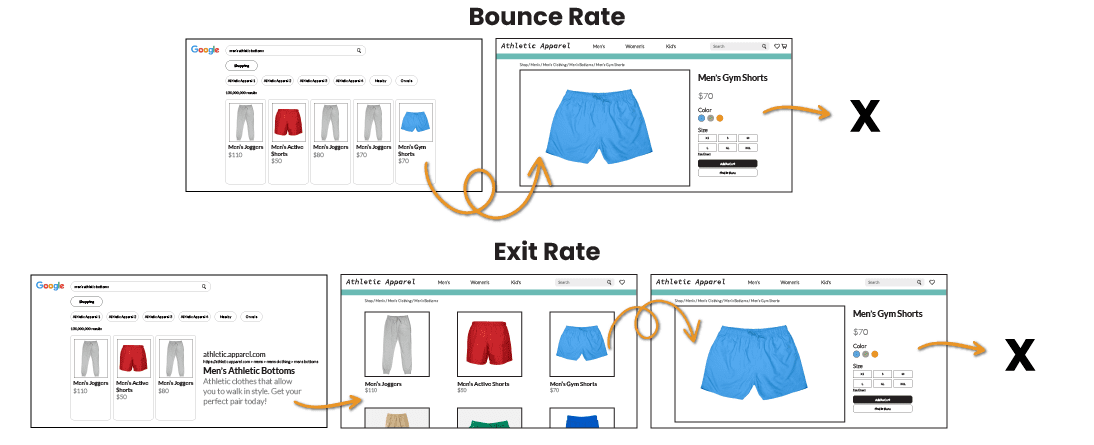
When it comes to analyzing website traffic, two terms that often get confused are bounce rate and exit rate. Google Analytics lists these metrics side-by-side, and although they both relate to the behavior of visitors on a page, they represent different types of user journeys. In this blog post, we’ll explore the key differences between bounce rate and exit rate, examine reasons to pay attention to each, and share some techniques to help improve these important metrics.
What Is Bounce Rate?
A page’s bounce rate is the percentage of users who enter your site through that page, then immediately leave your site before visiting any other pages. For example, this could be a user who enters your product page from a Google search, doesn’t see what they are looking for, and immediately returns to Google will contribute to the bounce rate of your product page.
ROI Definition | Bounce rate: The percentage of users who enter your site through that page, then immediately leave your site before visiting any other pages.
On the other hand, users who start elsewhere on your site and then click a link to your product page won’t affect that product page’s bounce rate, no matter what they do next.
For example, a user who enters your site on the homepage, clicks a banner spotlighting a new product, and ends up on the product page will not contribute to the product page’s bounce rate – even if their next action is to leave your site. That’s because the product page wasn’t their entry point to your site.
These examples illustrate the importance of having high-quality, relevant landing pages as your users’ first entry point into the site. A landing page with a low bounce rate indicates that it’s successfully enticing users to explore further into your site. A landing page with a high bounce rate is likely causing users to back out of your site and continue their search elsewhere.
What Is Exit Rate?
A page’s exit rate is the percentage of users who enter a page through any means, then leave your site from that page. Whether a user arrives at a given URL as the first page in their session or the twentieth, their next action will affect the page’s exit rate. If they leave your site, the exit rate will increase, whereas if they continue browsing and visit other pages, the exit rate will decrease.
ROI Definition | Exit rate: The percentage of users who enter a page through any means, then leave your site from that page.
Bounce Rate vs. Exit Rate

Although there are similarities between a page’s bounce rate and exit rate, the differences between these metrics can uncover key insights into user behavior.
A high bounce rate suggests that something about the page or your site is driving users away immediately. It could be a long loading time, a confusing or off-putting design, or a mismatch between the page and the ad or search query that brought the user to your site.
A high exit rate, on the other hand, suggests that users are giving up on that page, potentially due to dissatisfaction with its content or lack of a strong call to action or path forward.
The New Metric in Town: Engagement Rate
Google Analytics 4 (GA4) brings a new metric related to bounce rate and exit rate: engagement rate. Thankfully, engagement rate is easy to understand; it’s just the inverse of bounce rate. To convert from engagement rate to bounce rate, you can subtract the bounce rate from 100. So, a page with a bounce rate of 8% will have an engagement rate of 92%. Pages with low bounce rates will have high engagement rates, and vice versa.
ROI Definition | Engagement rate: The inverse of bounce rate, calculated by subtracting the bounce rate from 100.
Ideas to Improve Bounce Rate & Exit Rate
If you’ve identified a page with a higher bounce rate or exit rate than you’d like, here are some ways to retain visitors and encourage them to take action:
- Ensure your site’s design is simple and easy to navigate. Users who feel confused or overwhelmed are likely to exit your site before fully exploring what you have available.
- Provide links to additional content. For example, on a product page, consider a section with links to similar products to entice users into exploring your site further.
- Optimize for site speed and eliminate any bugs that users may encounter that would cause them to leave your site.
- Establish a clear call to action. Make sure your desired “next step” is the most prominent feature of the page.
A/B testing is a great way to experiment with the above suggestions. A/B tests allow you to make changes to your site for just a percentage of your users and measure the changes’ effect against the original site. A/B tests can use reduction of bounce rate or exit rate as a primary or secondary goal and are a great way to test new designs, page elements, and functionalities before committing developer bandwidth and 100% of your traffic to the new treatment.
A/B testing can give you invaluable information about what resonates with your audience the most. However, many businesses struggle to develop A/B tests that produce actionable results. In fact, the industry average A/B test win rate is just 12-15%. At ROI Revolution, our conversion rate optimization experts execute A/B tests at nearly triple that win rate! To explore the untapped growth opportunities we could uncover for you through A/B testing, send a message to our team today.

Tying It All Together: Bounce Rate vs. Exit Rate
If you are interested in seeing how A/B testing can help your business reduce bounce rate and increase conversion rate, consider partnering with an agency like ROI Revolution that specializes in conversion optimization, UX, and A/B testing. Send a message to our team to request an optimization audit of your site and uncover opportunities for reduced friction or increased motivation in your web presence.



